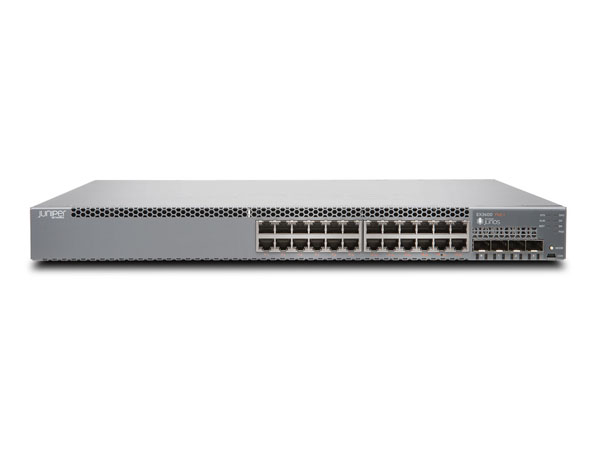Thông Số Kỹ Thuật EX3400-24P
| Physical Specifications | |
| Dimensions (W x H x D) | 17.4 x 1.72 x 13.8 in (44.2 x 4.4 x 35 cm) |
| Backplane | 160 Gbps (with QSFP+ ports) or 80 Gbps (with SFP+ ports) Virtual Chassis interconnect to link up to 10 switches as a single logical device |
| Uplink | Fixed 4-port uplinks can be individually configured as GbE (SFP) or 10GbE (SFP+) ports; 2 x 40G QSFP+ ports |
| System Weight | No power supply or fan module: 10.49 lb (4.76 kg) maximum With single power supply and two fan modules: 12.65 lb (5.74 kg) maximum 150 W AC power supply: 1.43 lb (0.65 kg) 600 W AC power supply: 1.82 lb (0.83 kg) 920 W AC power supply: 1.87 lb (0.85 kg) 150 W DC power supply: 1.43 lb (0.65 kg) Fan module: 0.16 lb (0.07 kg) |
| Environmental Ranges | + Operating temperature: 32° to 113° F (0° to 45° C) + Storage temperature: -40° to 158° F (-40° to 70° C) + Operating altitude: up to 10,000 ft (3048 m) + Nonoperating altitude: up to 16,000 ft (4877 m) + Relative humidity operating: 10% to 85% (noncondensing) + Relative humidity nonoperating: 0% to 95% (noncondensing) |
| Hardware Specifications | |
| DRAM | 2 GB with ECC |
| Flash | 2 GB |
| CPU | Dual Core 1 GHz |
| GbE port density per system | 24 host ports + four 1/10 GbE and two 40GbE uplink ports |
| PoE Support | yes |
| Total 30 W PoE+ Ports That Can Be Enabled | 24 ports up to 30W with 720W PoE+ Power Budget (W) 24 ports up to 15.4Wwith370WPoE+ Power Budget (W) |
| Packet-Switching Capacities (Maximum with 64-Byte Packets) | 288 Gbps |
| Software Specifications | |
| Layer 2/Layer 3 Throughput (Mpps) (Maximum with 64 Byte Packets) | 214 Mpps |
| Layer 2 Features | + Maximum MAC addresses per system: 32,000 + Jumbo frames: 9216 bytes + Number of VLANs supported: 4,096 + Range of possible VLAN IDs: 1-4094 + Port-based VLAN + MAC-based VLAN + Voice VLAN + Layer 2 Tunneling Protocol (L2TP) + Compatible with Per-VLAN Spanning Tree Plus (PVST+) + RVI (routed VLAN interface) + Persistent MAC (sticky MAC) + RSTP and VSTP running concurrently + IEEE 802.1AB: Link Layer Discovery Protocol (LLDP) + LLDP-MED with VoIP integration + IEEE 802.1ae Media Access Control Security (MACsec) + IEEE 802.1ak Multiple VLAN Registration Protocol (MVRP) + IEEE 802.1br: Bridge Port Extension + IEEE 802.1D: Spanning Tree Protocol + IEEE 802.1p: CoS prioritization + IEEE 802.1Q-in-Q: VLAN stacking + IEEE 802.1Q: VLAN tagging + IEEE 802.1s: Multiple Spanning Tree Protocol (MSTP) + Number of MST instances supported: 64 + Number of VSTP instances supported: 510 + IEEE 802.1w: Rapid Spanning Tree Protocol (RSTP) + IEEE 802.1X: Port access control + IEEE 802.3: 10BASE-T + IEEE 802.3ab: 1000BASE-T + IEEE 802.3ad: Link Aggregation Control Protocol (LACP) + IEEE 802.1ad Q-in-Q tunneling + IEEE 802.3ae: 10-Gigabit Ethernet + IEEE 802.3u: 100BASE-T + IEEE 802.3z: 1000BASE-X + IEEE 802.3x: Pause Frames/Flow Control + Layer 3 VLAN-tagged subinterface + PVLAN support + Multicast VLAN routing + Adding/removing single tag + Filter-based SVLAN tagging + Flexible CoS (outer .1P marking) + IEEE 802.3af: PoE + IEEE 802.3at: PoE+ |
| Layer 3 Features: IPv4 | + Maximum number of ARP entries: 16,000 + Maximum number of IPv4 unicast routes in hardware: 14,000 prefixes; 36,000 host routes + Maximum number of IPv4 multicast routes in hardware: 18,000 groups; 4,000 multicast routes + Routing Protocols: RIP v1/v2, OSPF v2 + Static routing + Layer 3 redundancy: VRRP + IP directed broadcast—traffic forwarding + Virtual router (VRF-Lite) supporting RIP, OSPF + Routing policy + Filter-based forwarding (FBF) + Unicast reverse-path forwarding |
| Layer 3 Features: IPv6 | + Maximum number of Neighbor Discovery entries: 8,000 + Maximum number of IPv6 unicast routes in hardware: 3,500 prefixes; 18,000 host routes + Maximum number of IPv6 multicast routes in hardware: 9,000 groups; 2,000 multicast routes + Neighbor discovery, system logging, Telnet, SSH, Junos Web, SNMP, Network Time Protocol (NTP), Domain Name System (DNS) + Routing protocols: RIPng, OSPF v3 + Static routing + IPv6 ACL (PACL, VACL, RACL) + IPv6 CoS (BA, MF classification and rewrite, scheduling based on TC) + MLDv1/v2 snooping + IPv6 ping, traceroute + IPv6 stateless auto-configuration + IPv6 Layer 3 forwarding in hardware + IPv6 Layer 3 redundancy: VRRP v6 + Virtual Router support for IPv6 unicast + PIM for IPv6 multicast |




Đánh giá